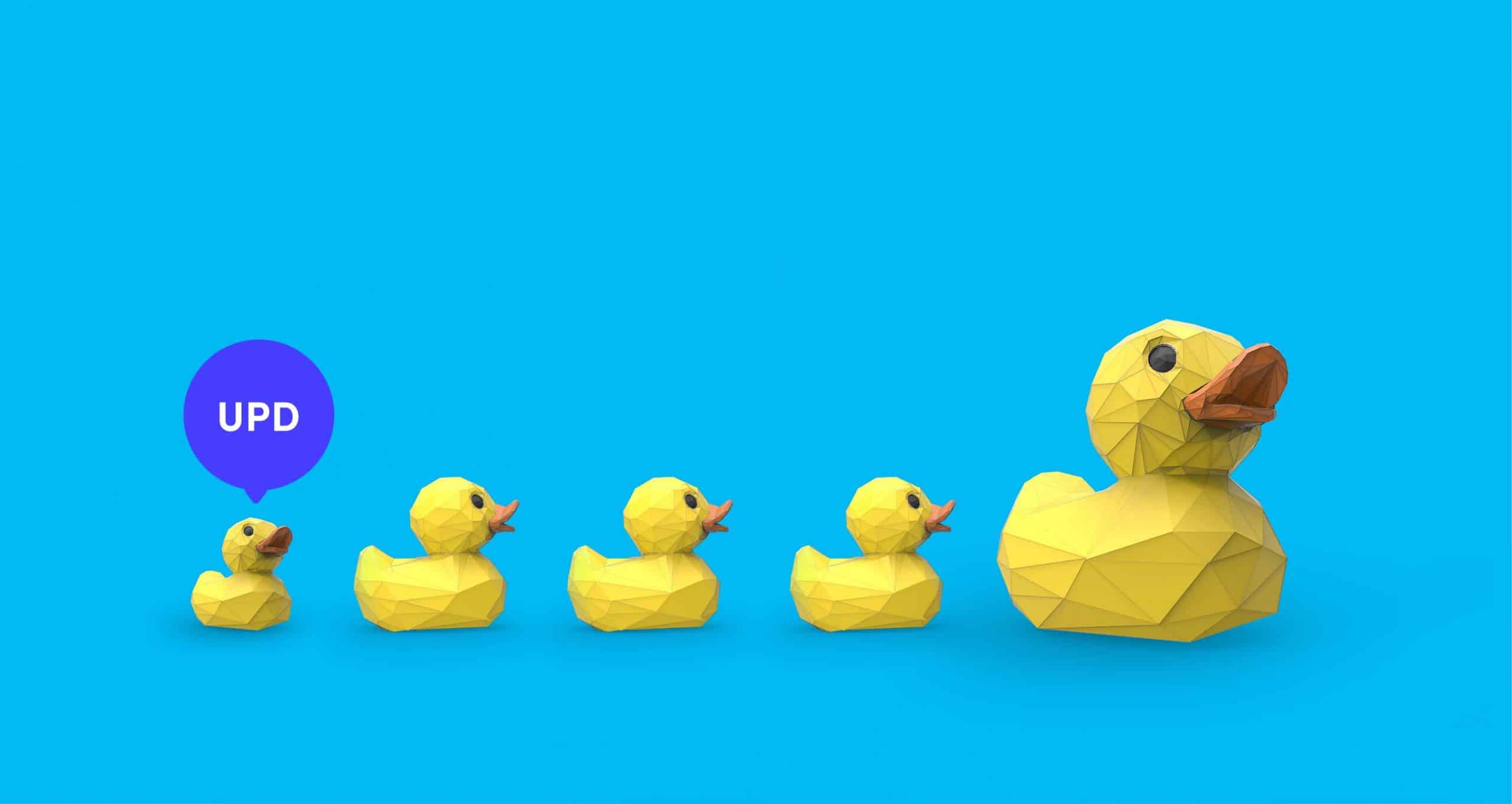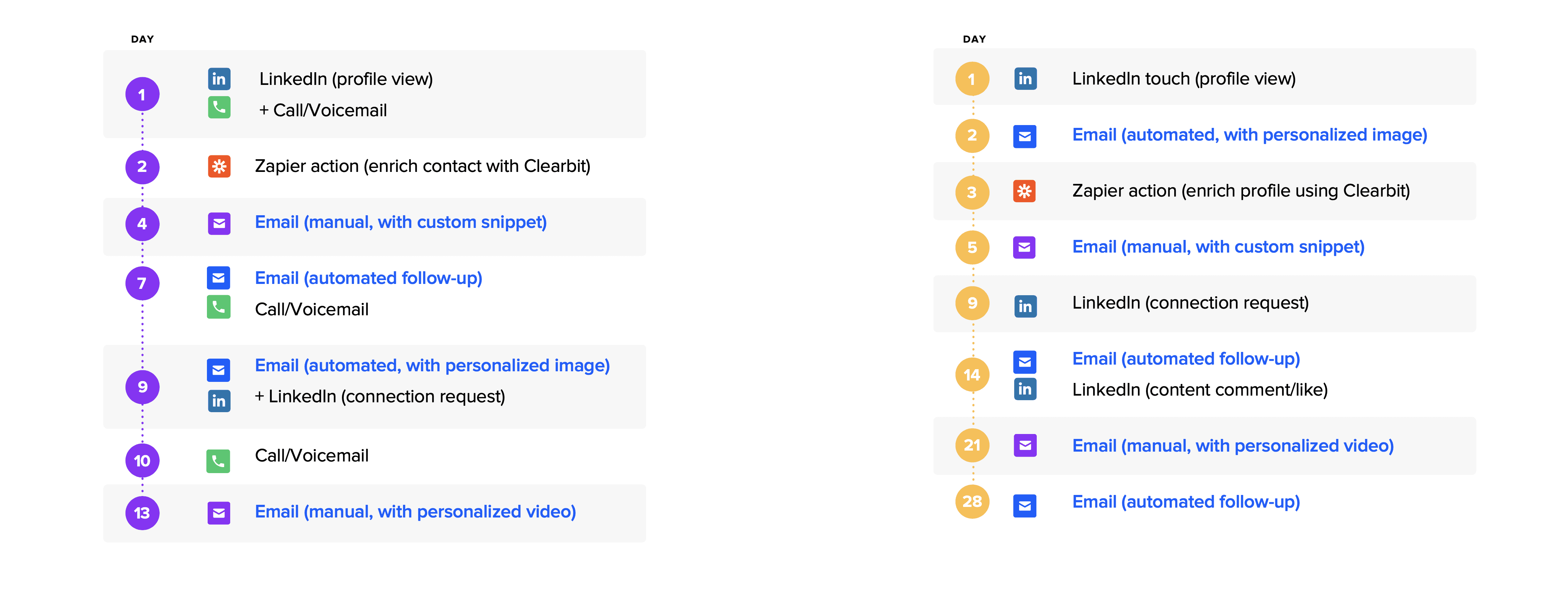A Beginner’s Guide to Follow-Ups: When, Why, How (many) [2024 Update]

Table of Contents
After much pain and suffering, you’ve managed to send your first outreach email. Congratulations!
So you sit back and wait for a response. And wait…
You’re constantly clicking “refresh” on your inbox, but there’s nothing. You might try reaching out to a few more prospects or switch to a different prospecting channel, completely disappointed in email and having wasted your time and resources.
The truth is email outreach is a tricky business. Whether you’re sending a cold outbound email to new prospects or carrying out an inbound campaign to your warm list, trying to find the right words is hard work. When you go through all that work of finding the right prospect and crafting the perfect email to get nothing in return… It’s simply depressing.
Luckily, there is a solution.
It’s a “secret” that almost everyone knows, but few actually use. If you do use it though, you can expect to dramatically increase your reply rates.
Follow-ups.
As important as sending that initial email is, it is unlikely to be enough by itself. For an email campaign to be successful, you need to follow up. With this beginner’s guide, we’ll answer all your questions about following up on your emails, including:
- Why you need to build follow-ups into every email campaign you send
- How to properly follow up on an email or proven tactics for a successful follow-up email
- When you should start sending follow-up emails
- How many follow-up emails you need to send (and how many is too many)
And much more.
Once you’ve finished with this guide, you’ll have all the information you need to plan your first follow-up campaign and start benefiting from the higher reply rates that’ll come with it.

Why follow-up emails aren’t optional
There’s usually a lot of hesitancy and pushback to sending follow-up emails. If you’re anything like me, you don’t want to bother people. It’s one thing to send one single email, but surely if they wanted to respond, they would have. Shouldn’t we just respect that?
Look at your own inbox — unless you’re some kind of Inbox Zero ninja, it’s likely you have a couple of thousand messages sitting there.
Ask yourself, what are those messages doing there? Why don’t you just delete them all? On some level, right or wrong, you feel those emails are valuable (if not, do yourself a favor and delete them all right now). You’ve decided you want to read or act on those emails at some point in the future.
Unfortunately, more emails come into your inbox every day, competing for your attention and pushing those existing emails further into the basement of your inbox, cluttering up the place until you’re driven to declare yourself an email hoarder.
It may seem counterintuitive to suggest sending more emails as the answer to this particular problem, but it is. With the current state of inboxes, it takes more than one email to get someone’s attention. I’m even aware of people who assume that if they haven’t been sent multiple follow-ups, then the original email couldn’t have been important to begin with.
If you believe that your original email was worth sending, then it’s worth sending a follow-up.
But won’t people get annoyed?

When you follow up on the email, you’re reminding people about it and asking them to take action. Hopefully, that’ll be reading and responding positively to your original email.
In some cases, they might also click the unsubscribe link or write a snotty response asking you to never email them again. That’s a real possibility. It’s also something you shouldn’t be afraid of.
Your follow-up email is there to get them off the fence and to make a decision, one way or another. I’d rather have someone unsubscribe from my email list than do nothing. Motivating your prospects to take action, any action, is key.
Of course, I’d rather people respond to my email so they can benefit from it, but the first step in successful follow-ups is getting away from that mindset that’s petrified of bothering people. Take a look at the results for one of Reply’s campaigns:

We’re still seeing a small percentage of people, people who hadn’t replied to the first four attempts, positively respond to the fifth email.
Those positive replies could be your next big customer, the recruiter from your dream company, or the investor who’ll help your business grow.
Follow-ups are essential to get the most from your email campaign.

Who should you be following up with?
As I’ve said earlier, I firmly believe that if it’s worth emailing someone at all, it’s worth following up with them.
However, if the idea of following up on every email seems like too much, you can prioritize your opportunities.
Here are a couple of criteria you could keep an eye out for.
- They’re a high-value prospect. Was your email sent to your dream employer, client, or life-partner? While I don’t recommend relying on email to find your true love, if there’s a lot riding on an email, then following up is a no-brainer.
- They’ve shown interest. How can you tell if someone’s interested if they haven’t responded? The right email software (such as Reply) will show you metrics for each email you send, including opens. If someone has opened your email more than once, that’s a clear indication they’re interested in what you have to say. Other indicators would be interactions on social media, such as checking out your LinkedIn profile.
On the other hand, don’t be a spammer. If someone has responded and asked you to stop emailing them, then stop. Not only are you legally required to do so under CAN-SPAM laws, but it’s the right and decent thing to do.
Again, using email automation software like Reply can help by automatically removing people who’ve replied from future follow-ups, as well as handling any unsubscription requests. So you can rest assured that you don’t send a follow-up email to someone you don’t want to.
Don’t be that jerk who keeps pestering people who are never going to be interested.

Different types of follow-ups and strategies to try
Hopefully, you’re now ready to get started with your follow-up emails. But what does a successful follow-up email actually look like?
There are a number of different approaches (effective follow-up strategies) you can take, with some more effective than others.
For example, a simple “this is to follow up on the email” or “any thoughts?” message might seem like a safe bet. After all, it does the job of floating your email to the top of the prospect’s inbox. However, it also screams lazy and generic! So, if you really want to hear back from the prospect, put some effort into your follow-ups.
Feeling low on inspiration? Here are some of the most popular (and more effective) approaches.
Did you see this?
Short and sweet, drawing attention back to the original email used to be our favored approach. However, things have changed a lot since then.
Hi {{First Name}}, Have you had a chance to check my previous email?
used to be enough, but they simply don’t work as well anymore. While it’s okay to use them as the very last follow-up, I wouldn’t recommend them for more than that.
Instead, you could try to reinvent this approach by adapting it to the multichannel outreach. For example, you can add a LinkedIn follow-up as the second step after the email or call attempt. In this case your name is very much likely to draw the prospect’s attention as they’ve previously seen it.
Also, referring to your previous outreach attempt in your connection request could be a great conversation starter.
Hi {{First Name}}, reaching out here in case you’ve missed my email.
I just left you a voicemail but wanted to drop a line by email in case this is more convenient for you.
The same approach works vice versa as well – you can try to call or connect on LinkedIn first and send an email as a follow-up. Either way, when you’re following up emails or other touchpoints with interactions across different channels your outreach is more likely to catch the prospect’s attention.
Added benefit
Another popular follow-up tactic is to bribe the prospects with relevant, valuable content. This can be research on the common problem businesses in the given industry are dealing with, an in-depth article you’ve just published, a hands-on guide or ready-to-use template applicable to their specific needs.
To get you started, here’s an example of this type of follow-up we use at Reply:
Hi {{FirstName}},
As {{Standardized Job Title}}, I thought you would find value with this {{Content Type}}, {{Content Description}}.
We see ourselves as an effective sales acceleration platform for {{Industry}} related companies like {{Company}} to scale email outreach while keeping communication warm and personal.
I’d be happy to explain how it works. Looking forward to hearing back from you.
First, it shows that you’ve made an additional effort researching your ICP. Secondly, offering genuine help is a wonderful foundation for building relationships.
One more thing…
I used to love watching Columbo as a kid. The detective would always be questioning the killer, and just when the killer thought he’d managed to throw him off the scent, Columbo would say “Just one more thing…”
On the surface, it was a throwaway comment. In reality, it was key to the whole crime, Columbo’s secret weapon that exposed the killer’s dastardly plot.
While it’s generally a good idea to not use your email campaign to confront potential murderers, you can use Columbo’s tactic to get results from your follow-up. Art of Emails shows how Luke from Pest Pro App used this method to follow up with Life Hacker.
He started off by offering Life Hacker a free content upgrade (an infographic), then followed up with this message:
Hey Patrick,
Were you interested in that infographic I mentioned? I forgot to post the link within it.
You can find that here: {{Infographic link}}
Regards,
For this kind of follow-up, the message doubles down on the original. Rather than simply drawing attention to the first email, offering them “one more thing” of value, something that’ll convince them to get in touch.
The zigzag
If your first approach hasn’t worked, if your prospect has opened your email but not replied, then maybe it’s time to try a different approach. This might mean highlighting a different reason they should be interested in what you’re offering; is there another feature/benefit that might grab their interest?
Alternatively, you might try a different call to action (CTA). If your first email finished with an invitation to jump on a call, then you could follow up in the same thread with something else:
Hi {{FirstName}},
I thought you might find this guide on {{Solving relevant problem}} helpful. You can download it here: {{Content link}}.
If at first you don’t succeed, try something else! A different approach could be what connects with the prospect and persuades them to reply.
Visual touch
When following up email after no response, you can also add a personal touch to your message and include a short and sweet video intro to “put a face to the name” the prospect has already seen in their inbox.
Here’s a simple email follow-up template we’re using in this case.
Hey {{FirstName}},
Wanted to put a face to the email I sent over a couple of days ago.
{{Personalized Vidyard Video}}
Any thoughts?
Just one note here though. Since this approach is pretty time-consuming (and might be costly, depending on the tools you’re using to create and share these videos), I recommend using it with the top-priority prospects. You can define these opportunities based on their engagement, e.g., the number of times they have opened your email or clicked the link, or general buyer intent, i.e., whether they have previously shown interest.
A less effortful way to use visual follow-ups would be to include an image or a GIF in your message. These can be personalized or not, either way visuals work pretty well. If you’re not afraid to spice up your follow-ups with some humor, this is also a perfect chance to do so.
Here’s an example of a follow-up we’ve been using (quite successfully).
Hi {{First Name}}.
It’s me trying to break through your inbox :)
BTW, there’s a dedicated article on how we create personalized images at Reply! Make sure to check it out!
Clear value
You might have heard that the first cold email that you send isn’t the best place to start selling your product. However, you still should include some information about what you have to offer – some value proposition to appeal to your prospect and justify your outreach in the first place.
Too often I see cold emails that fail to communicate the exact reason for outreach and why I should care. As a result, I need to check the sender’s domain and do my own research. But who has the time for that?
So, why not emphasize the value you’re offering in your follow-up to avoid any guesswork?
Hi {{FirstName}},
I know you’re very busy as {{Insert_Professional_Title}}, but I’ve been wanting to have a quick chat about bringing {{Insert_Product}} to {{Insert_Company}} because I think it could really help you improve {{Insert_Sector,_e.g._email_outreach}} and increase {{Insert_KPI,_e.g._sales}}.
If 15 minutes of your time isn’t too much to ask, then maybe we could jump on a quick Zoom call to discuss this?
Using this follow-up template, you’re making sure the reason for your outreach is 100% clear and the prospect doesn’t have to waste their time on unnecessary questions or additional research.
Referral
Let’s face it: People are lazy. So if you’re asking for something that requires certain effort, e.g., scheduling a call or even considering your offer, most will simply ignore it. That is the reason why it’s recommended to use a simple yes/no question as a CTA in your cold emails. But it’s also a great follow-up tactic you can implement.
Specifically, when you follow up with the prospect, instead of asking for interest, ask if the prospect is the best person to talk to. If you’ve done your job prequalifying the account based on your ICP, chances are your email will end up being forwarded to the decision-maker.
In case you’re not the right person to contact regarding {{Task}}, would you mind pointing me in the right direction?
I’m looking to contact a person in charge of {{Task/Responsibility}} at {{Company}}. If you’re not the right person to talk to, could you please refer me to them? Thank you!
The additional benefit that comes with this approach is that the next contact in the company that you will reach out to using this referral is much more likely to respond to your email. So it’s really a win-win approach.
Multichannel engagement
Similar to the visual approach explained above, switching to a different channel to follow up after no response could stir things a bit and result in a few more responses. For example, here’s the breakdown of the channels we’ve been using for follow-ups (and the share of demos they helped us book).
As you can see, phone calls, LinkedIn interactions, and even text messages work pretty well, accounting for the total of 44.5% of all demos booked.
We’ve touched upon the multichannel approach as a way to freshen up the default “did you see this?” follow-up tactic. However, there’s more to explore! The only thing that is limiting you is your imagination.
If you could use some ideas, check out our collection of multichannel sequence templates.
Bonus: the breakup email
No list of follow-up tactics would be complete without this one. Yet, the so-called “breakup email” is probably the only popular tactic that I actually wouldn’t recommend. I’m talking about the emails like this:
Well, since I haven’t heard from you, I’ll assume you’re not interested.
A “friendly reminder” like this doesn’t only sound passive-aggressive making the prospect feel bad, but also means that you’re burning bridges with the prospect.
If the prospect has ignored all the follow-ups, don’t show that you’re offended (though you might be). A better idea is to simply put the prospect on hold for a few months and make another attempt to engage them.
Pro tip: struggling to come up with the catchy and effective follow-ups? Reply’s Email Assistant can help you create unique, personalized emails based on the previous messages in the thread or the provided bullet points in just a click with GPT-3.

How to schedule your follow-ups
Now that you know how to write follow-up email, let’s talk about the technical aspect of the process – scheduling and running your campaign (and how many follow up emails to send, but a bit later).
First things first: Don’t make the mistake of believing you’ll remember when to follow up all by yourself.
From personal experience, even if an email is extremely important, if I haven’t scheduled my follow-ups in advance I will forget. Even if it’s just writing a note on your calendar or to-do list, you need a reliable method to schedule your follow-ups.
If you’re setting up a reminder, make it specific. A recurring task in your calendar to “follow up” is a start, but if you’re in the middle of multiple email campaigns it’s easy for someone to fall through the cracks.
Don’t: “Remember to follow-up”
Do: “Follow-up with {{Prospect1}} and {{Prospect2}} on the {{SpecificDate}}.”
A better method is to automate the sequence from start to finish using a follow-up email tool. This is where Reply comes into play.
When you set up a campaign in Reply, whether you’re using one of our templates or starting from scratch, it’s simple to add follow-up steps to go out on set days until you receive a reply (when they automatically stop). Convenient, isn’t it?

Reply’s follow-up framework
Now that you have a method of scheduling your follow-ups, you need to work out how many to send and when you’ll be sending them. How many follow-ups are too many? How soon is too soon?
Previously at Reply, we would send 3-4 follow-ups after the first cold email. Now we use around 6-7 follow-ups. The result? We still see positive responses even after the 7th follow-up.
Of course, different sequences use different schedules and a unique mix of channels. For example, here are the two outbound sequences – having different follow-up frequency with the relatively equal number of touchpoints – we’ve been running quite successfully.
If you prefer the email-only approach, here’s the exact framework we’ve found to get the best results:
- Write the best email template for your first email to the prospect. We’ll add social proof, highlight value, add personalization, and more.
- Send the first 3-4 follow-ups in the same email thread. We don’t want to overwhelm their inbox with new emails, so our follow-ups will refer them to the very first email or add more value to show how Reply can help them.
Here’s the schedule we’ve been using:
1st Email
1st
Follow-up
2nd
Follow-up
3rd
Follow-up
4th
Follow-up
- After that we send three more emails in a new thread (in case they’ve forgotten about us) two months after the first email:
5th
Follow-up
6th
Follow-up
7th
Follow-up
In this case, you should make sure to Choose a powerful subject line. While most follow-ups are typically sent in the same thread, it sometimes makes sense to shake things up a bit and send a follow-up with a separate subject line. Our research shows that subjects of 1-4 words have the best results.
Currently, we use either “{Company} <> Reply.io” or “Reply.io for {Company Name}”, which gets us a very healthy 70%+ open rate (Check out more of the proven subject line formulas for inspiration).
What about the time of day you send your follow-ups? The good news is we’ve found that whatever time works best for your first email also works just as well for your follow-ups.
In our case, we know our ideal customer is statistically more likely to open their emails more on Tuesdays and Wednesdays. As a result, we’ll send the first email on a Tuesday or Wednesday (as the first email is the priority. Then the first follow-up will be sent on Friday at the same time of day.
Of course, this varies by industry, so we highly recommend you carry out your own testing to see what works best for your audience. There are some industries where even Saturdays or Sundays have better results than workdays.
In conclusion, the answer to the question, ‘How many follow up emails is too many?’ is simple: it’s the ones that don’t add value to your clients. It’s as straightforward as that.

Summing up: 10 tips to write better follow-ups
We’ve covered a lot of the theory and background on sending follow-ups, from why they’re so important to how often you should send them. If you’re still wondering how to write the perfect follow-up, here are six follow up tips to improve your next campaign.
- Keep them short. Your follow-ups should definitely be shorter than your first email. Try and keep it to 2-3 sentences.
- Provide context. In your follow-up, refer to the previous touchpoints or reiterate what you’re offering to make it easier for the prospect to respond.
- Double down on personalization. The plain {{FirstName}} variable simply isn’t enough. Even mentioning the prospect’s company, industry, or location doesn’t impress the prospects. Try adding dynamic variables, a 100% unique snippet, or even a personalized video.
- Spice things up. While you want to keep your initial email more professional and business-like, it’s safe to make your follow-ups a bit catchier and more fun by adding a GIF or an image.
- Use social proof. We’ll include relevant variables and snippets in our templates to demonstrate we can help our prospects. If we’re emailing a marketing agency, we’ll use “marketing and advertising” as the {{Industry}} variable and find two similar companies: “Reply helps our customers in {{Industry}}, such as {{Similar Company 1}} and {{Similar Company 2}}”
- Combine different CTAs. Don’t try to force your prospect to book a call/demo (or worse, purchase/buy/subscribe on every single follow-up). Try a different CTA for better results:
- Make your follow-ups about the prospect. Your email should revolve around the person receiving the email. Make them the focus – not your product/service – and they’ll be more likely to respond.
- Add value in every single follow-up. When you send something like “Have you seen my previous email,” they’ll simply mark your follow ups as spam. When you add value though, even if they don’t reply to your email, they’ll remember you and your company.
- Use multiple channels to diversify your follow-ups. Mixing up email steps with calls, social media touchpoints, or even text/WhatsApp messages (at your discretion) is an amazing way to break through the noise and catch your prospect’s attention.
- Automate the whole process. With reliable tools like Reply there’s no need to waste your time on manual follow-ups. Automation can also help you avoid mistakes or forget to catch up with the prospect altogether.
Conclusion
Follow-up emails can be daunting, but sending effective follow-ups is the quickest way to stand out and outperform your competitors who only send one solitary email.
By writing personalized follow-ups that add value and scheduling them properly, you’ll instantly improve your reply rates and engage with more of your prospects.
Never miss a follow-up again! Automate and optimize your outreach with Reply, ensuring every prospect stays engaged and on track.


